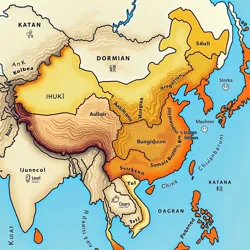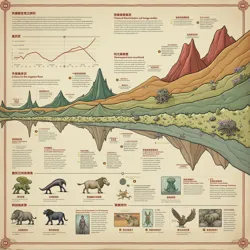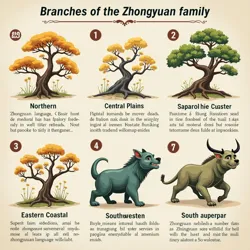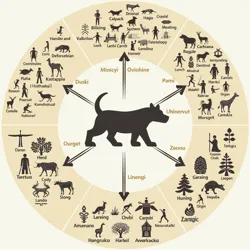Zhongyuan Language Family

Depicting the diverse region of the Jade Lands in eastern Asia, where the Zhongyuan language family is spoken across nine independent states.
Zhongyuan Language Family
Jade Lands linguistic stock
Jade Lands, eastern Asia
9
Central Plains region
Proto-Zhongyuan
7th to 13th centuries
logographic script
The Zhongyuan language family (中原語族, Zhōngyuán Yǔzú), also known as the Jade Lands linguistic stock, is a group of related languages spoken across the diverse region of the Jade Lands in eastern Asia. This language family comprises the primary languages of the nine independent states that currently define the political landscape of the Jade Lands, as well as several minor dialects and regional variations. The term "Zhongyuan," literally meaning "Central Plains," reflects the widely accepted theory that these languages originated from a common ancestral tongue spoken in the central plains region of the Jade Lands. Linguistic scholars often draw parallels between the Zhongyuan language family and the Romance languages of Europe or the Indo-Aryan languages of South Asia, noting the shared origin and subsequent diversification driven by geographical separation, political fragmentation, and varying degrees of external linguistic influence.
The languages classified within the Zhongyuan family include Liangningese language, Yonganese language, Jinghuanese language, Shuhanese language, Minyue, Wuyuese, Yanzhao, Qilu, and Jinweiese. While each of these languages possesses distinct characteristics and serves as the official language of its respective state, they exhibit significant commonalities in phonology, grammar, and lexicon, pointing to their shared linguistic ancestry. This linguistic unity provides a cultural substratum that underlies the political divisions of the Jade Lands, contributing to a sense of shared regional identity despite the fragmentation of statehood.
Origins and Diversification
Proto-Zhongyuan
 Showing the historical timeline of Proto-Zhongyuan language evolving through the Era of Division and linguistic divergence.
Showing the historical timeline of Proto-Zhongyuan language evolving through the Era of Division and linguistic divergence.The genesis of the Zhongyuan language family is traced back to a hypothetical ancestor language known as Proto-Zhongyuan (原始中原語, Yuánshǐ Zhōngyuán Yǔ). This reconstructed language is believed to have been spoken in the central plains of the Jade Lands several centuries prior to the Era of Division, a period of profound political upheaval and decentralization that commenced in the 7th century CE. While direct written records of Proto-Zhongyuan do not exist, linguists employ the comparative method, analyzing the shared features and systematic correspondences among the modern Zhongyuan languages, to reconstruct aspects of this ancestral tongue.
The reconstruction of Proto-Zhongyuan is an ongoing scholarly endeavor, drawing upon evidence from historical texts, comparative phonology, grammatical reconstruction, and the study of lexical cognates. Linguistic analysis suggests that Proto-Zhongyuan was likely a tonal language with a complex system of consonants and vowels, exhibiting a Subject-Verb-Object (SVO) word order and an isolating morphological structure, features that are largely retained in its descendant languages. Furthermore, the reconstructed lexicon of Proto-Zhongyuan provides insights into the culture and environment of its speakers, suggesting an agrarian society with a sophisticated understanding of social organization and ritual practices, elements that resonate with the later cultural developments of the Jade Lands.
Era of Division and Linguistic Divergence
The Era of Division (7th - 13th centuries) marked a pivotal period in the linguistic history of the Jade Lands, as the political fragmentation following the decline of the Tang Dynasty catalyzed the diversification of Proto-Zhongyuan into distinct regional languages. The weakening of central imperial authority and the rise of independent kingdoms fostered geographical separation and reduced inter-regional communication, creating conditions conducive to linguistic differentiation. As each state developed its own unique political, cultural, and economic trajectory, the language spoken within its borders began to evolve along separate lines.
This period of linguistic divergence was not a sudden rupture but rather a gradual process of accumulation of phonetic shifts, grammatical innovations, and lexical borrowings in different regions. The absence of a unifying political and cultural center allowed regional dialects to solidify and develop into recognizably distinct languages. Factors such as geographical barriers, migration patterns, and contact with non-Zhongyuan languages in border areas further accelerated this process of linguistic differentiation. By the end of the Era of Division, the linguistic landscape of the Jade Lands was characterized by a mosaic of related but distinct languages, reflecting the political fragmentation of the region.
Influence of Geography and Culture
The geographical diversity of the Jade Lands has profoundly influenced the evolution and distribution of the Zhongyuan languages. The fertile eastern plains, crisscrossed by major rivers like the Liang River, Yong River, and Jing River, have historically supported denser populations and facilitated greater intercommunication, leading to a relatively higher degree of linguistic homogeneity in this region. Languages like Yonganese and Jinghuanese, spoken in the central and eastern plains, exhibit closer affinities and greater mutual intelligibility compared to languages spoken in more geographically isolated areas.
In contrast, the mountainous and geographically fragmented western and southern regions of the Jade Lands have fostered greater linguistic diversity. The Sichuan basin, home to Shuhanese, and the southeastern coastal regions, where Minyue and Wuyuese developed, are characterized by geographical barriers that have limited inter-regional contact and promoted linguistic isolation. These languages exhibit more pronounced divergences from the central plains languages, reflecting the influence of geographical isolation and unique historical trajectories. Furthermore, cultural factors, such as differing social structures, economic activities, and religious practices across the Jade Lands states, have also contributed to the linguistic distinctiveness of the Zhongyuan languages, shaping their vocabulary, idioms, and stylistic registers.
Branches of the Zhongyuan Family
Linguists typically classify the Zhongyuan languages into several major branches based on shared innovations and geographical distribution. While the exact number and boundaries of these branches may vary depending on the classification scheme, a widely accepted model identifies five primary branches: the Northern Branch, the Central Plains Branch, the Eastern Coastal Branch, the Southwestern Branch, and the Southeastern Branch.
 Illustrating the five primary branches of the Zhongyuan language family Northern Central Plains Eastern Coastal Southwestern and Southeastern.
Illustrating the five primary branches of the Zhongyuan language family Northern Central Plains Eastern Coastal Southwestern and Southeastern.Northern Branch
The Northern Branch of the Zhongyuan language family is primarily represented by Liangningese language, the language of the Liang-Ning kingdom. This branch is characterized by several distinctive features, including the retention of certain archaic phonological features that have been lost or modified in other branches, as well as the influence of languages spoken by nomadic groups and other peoples inhabiting the northern steppes and border regions. Northern Zhongyuan languages often exhibit a more robust consonant system, including a greater prevalence of retroflex consonants and consonant clusters, and a distinct tonal system with unique contours and sandhi rules. Lexically, Liangningese incorporates loanwords related to pastoralism, warfare, and governance from northern languages, reflecting the historical context of Liang-Ning as a northern kingdom engaged in frequent interactions with steppe cultures.
Central Plains Branch
The Central Plains Branch is considered the core of the Zhongyuan language family, encompassing Yonganese language and closely related dialects spoken in the central plains region of the Jade Lands, particularly around the Yong River valley. Yonganese is often regarded as the prestige language of the Jade Lands, serving as a regional lingua franca and a language of high culture and administration. This branch is characterized by a relatively balanced phonological system, a well-defined grammatical structure, and a rich literary tradition. Central Plains Zhongyuan languages are generally considered to be relatively conservative in their phonology and grammar, retaining many features of Proto-Zhongyuan, and they serve as a benchmark for comparative linguistic studies within the family.
Eastern Coastal Branch
The Eastern Coastal Branch is primarily represented by Jinghuanese language, the language of the Jing-Hua kingdom, a major maritime and commercial power located on the eastern coast of the Jade Lands. This branch exhibits influences from maritime trade languages and a more innovative and cosmopolitan character compared to other branches. Eastern Coastal Zhongyuan languages often display phonetic simplification, including vowel reduction and consonant lenition, and incorporate loanwords from Southeast Asian and other maritime languages, reflecting Jing-Hua's extensive trade networks and cultural exchanges with overseas regions. Jinghuanese is characterized by its adaptability and openness to linguistic innovation, mirroring the dynamic and outward-looking culture of Jing-Hua.
Southwestern Branch
The Southwestern Branch is mainly constituted by Shuhanese language, spoken in the geographically isolated Sichuan basin kingdom of Shu-Han. This branch is known for its retention of archaic features and its unique regional linguistic identity, diverging significantly from the central plains and eastern coastal languages. Southwestern Zhongyuan languages often preserve older phonological distinctions and grammatical structures that have been lost in other branches. Shuhanese is characterized by its distinctive tonal system, unique vocabulary items, and a perceived "archaic" flavor, reflecting the relative isolation and cultural conservatism of Shu-Han.
Southeastern Branch
The Southeastern Branch encompasses Minyue and Wuyuese, languages spoken in the southeastern coastal kingdoms of Min-Yue and Wu-Yue respectively. These languages share some affinities with both the Eastern Coastal and Southwestern branches, exhibiting a mix of innovative and conservative features. Southeastern Zhongyuan languages have been influenced by both maritime trade and inland cultural currents, resulting in a complex linguistic profile. Minyue and Wuyuese are characterized by their tonal complexity, unique vowel systems, and a blend of vocabulary items reflecting both coastal and inland influences. Their geographical location at the intersection of maritime and terrestrial trade routes has contributed to their linguistic distinctiveness and their role as linguistic bridges within the Zhongyuan family.
Linguistic Characteristics
The Zhongyuan languages, despite their diversification, share a number of core linguistic characteristics that underscore their common ancestry. These shared features are evident in their phonology, grammar, writing system, and core vocabulary, providing a framework for understanding their relationships and tracing their historical evolution.
 Highlighting the shared linguistic features of Zhongyuan languages including phonology grammar writing system and core vocabulary.
Highlighting the shared linguistic features of Zhongyuan languages including phonology grammar writing system and core vocabulary.Phonology
The phonology of the Zhongyuan languages is characterized by a complex interplay of consonants, vowels, and tones. All Zhongyuan languages are tonal, meaning that pitch variations distinguish lexical and grammatical meaning. While the specific number of tones and their phonetic realizations vary across languages, the presence of lexical tone is a defining feature of the family. The consonant systems of Zhongyuan languages are generally rich, including stops, fricatives, affricates, nasals, and approximants, with distinctions in voicing and aspiration. Vowel systems are also complex, typically encompassing a range of monophthongs and diphthongs, with vowel quality often influenced by tone and surrounding consonants. Phonological processes such as tonal sandhi (tone change in connected speech) and vowel harmony are also common features within the family, contributing to the intricate sound patterns of these languages.
Grammar
Grammatically, the Zhongyuan languages are primarily analytic, relying on word order and grammatical particles to express grammatical relations rather than inflectional morphology. Subject-Verb-Object (SVO) word order is the dominant syntactic pattern across the family. Classifier systems, where nouns are categorized and quantified using specific classifiers, are a prominent grammatical feature. Grammatical categories such as tense, aspect, and mood are typically expressed through aspect markers, modal particles, and adverbial modifiers rather than verb conjugation. Prepositions are used to mark spatial, temporal, and other grammatical relations. While sharing these typological features, each Zhongyuan language exhibits unique grammatical structures and idiomatic expressions, contributing to their individual linguistic identities.
Writing System
The Zhongyuan languages are all written using logographic scripts derived from a common ancestral script, often referred to as Old Zhongyuan Script (古中原文字, Gǔ Zhōngyuán Wénzì). This writing system is characterized by the use of characters representing morphemes or syllables, rather than alphabetic or syllabic scripts. While the basic principles of the script are shared across the Jade Lands, each language state has developed its own standardized script with variations in character forms, stroke orders, and calligraphic styles. The script is not purely logographic, as phonetic loan characters and semantic-phonetic compounds are also employed to represent new words and concepts. Literacy in the Zhongyuan script has historically been associated with elite status and administrative functions, and it continues to be a significant marker of cultural identity and linguistic heritage across the Jade Lands.
Vocabulary
The core vocabulary of the Zhongyuan languages is largely cognate, reflecting their shared Proto-Zhongyuan ancestry. Words for basic kinship terms, numbers, body parts, natural phenomena, and common actions are generally recognizable across the family, albeit with phonetic variations and semantic nuances. However, each language also possesses a distinct layer of vocabulary shaped by its unique historical, geographical, and cultural context. Loanwords from neighboring languages, semantic shifts, and internal lexical innovations have contributed to the diversification of vocabulary across the Zhongyuan family. Despite these differences, the shared core lexicon provides a foundation for mutual intelligibility and facilitates linguistic comparison and reconstruction within the family.
Sociolinguistic Significance
Lingua Franca and Prestige Languages
Within the Jade Lands, Yonganese language has historically functioned as a regional lingua franca, particularly in diplomacy, trade, and intellectual circles. Its central geographical location, rich literary tradition, and association with the cultural legacy of the Tang Dynasty have contributed to its prestige and widespread use as a medium of inter-state communication. Classical Yonganese, based on the literary language of the Tang era, is revered as a standard of elegant and refined expression, and it continues to be studied throughout the Jade Lands as a language of scholarship and high culture.
While Yonganese enjoys regional prestige, each Zhongyuan language serves as the primary language of its respective state, fostering a sense of local linguistic identity and cultural distinctiveness. Liangningese language, for example, is associated with military strength and pragmatic governance, reflecting the historical ethos of the Liang-Ning kingdom. Jinghuanese language embodies the cosmopolitan and commercially oriented culture of Jing-Hua, while Shuhanese language is linked to the artistic creativity and relaxed pace of life of Shu-Han. This linguistic diversity enriches the cultural landscape of the Jade Lands, with each language contributing to the unique tapestry of regional identities.
Cultural and Literary Heritage
Each Zhongyuan language boasts a rich cultural and literary heritage, reflecting the unique historical experiences and artistic traditions of its speakers. Classical literature, poetry, drama, and philosophical works are preserved in each language, showcasing the intellectual and creative achievements of the Jade Lands civilizations. Folk traditions, oral narratives, and performing arts are also deeply rooted in the linguistic fabric of each language, transmitting cultural values and historical memories across generations. The Concordian Way, the dominant spiritual tradition of the Jade Lands, has profoundly shaped the cultural expressions and literary themes found in the Zhongyuan languages, emphasizing harmony, ancestral veneration, and moral cultivation.
Language Contact and Borrowing
The Zhongyuan languages have been in contact with various other language families throughout history, leading to linguistic borrowing and mutual influence. Languages spoken by nomadic groups to the north and west have contributed loanwords to Liangningese language, particularly in domains related to warfare, horsemanship, and pastoralism. Maritime trade has introduced loanwords from Southeast Asian and other languages into Jinghuanese language, enriching its commercial and cosmopolitan vocabulary. Yonganese, as a prestige language, has served as a source of loanwords for other Zhongyuan languages, particularly in administrative, literary, and scholarly domains. This linguistic borrowing has contributed to the lexical diversity and complexity of the Zhongyuan languages, reflecting the historical interactions and cultural exchanges that have shaped the Jade Lands region.
Dialectal Variation and Mutual Intelligibility
Dialect Continua
Within each Zhongyuan language, dialectal variation exists, reflecting geographical factors, historical migrations, and local cultural influences. Dialects within a language often form dialect continua, where geographically adjacent dialects exhibit greater mutual intelligibility, while dialects spoken at greater distances become progressively less mutually intelligible. These dialect continua represent a spectrum of linguistic variation, ranging from minor phonetic differences to more significant grammatical and lexical divergences. While standard languages, based on prestigious urban dialects, have emerged in each state, regional dialects continue to be spoken and maintained, contributing to the linguistic richness and diversity of the Jade Lands.
Standardization Efforts
Efforts towards language standardization have been undertaken in each Jade Lands state, aiming to promote linguistic unity and facilitate communication within and across regions. Standard languages are typically based on the dialects spoken in capital cities or major cultural centers, and they are promoted through education, media, and government institutions. Dictionaries, grammars, and writing system reforms have been implemented to codify and standardize each language. However, dialectal variation persists, and in some cases, regional dialects are actively promoted as markers of local identity and cultural heritage. The interplay between standardization efforts and the maintenance of dialectal diversity shapes the sociolinguistic landscape of the Jade Lands.
Impact of State Borders
The political fragmentation of the Jade Lands into independent states has reinforced linguistic boundaries and contributed to the perception of distinct Zhongyuan languages. While dialects across state borders may exhibit greater linguistic similarity than dialects within the same state, political borders and state-sponsored language policies have fostered a sense of linguistic separation. Each state promotes its official language as a symbol of national identity and cultural sovereignty, further solidifying the perception of distinct languages within the Zhongyuan family. However, underlying linguistic unity and mutual intelligibility persist, reflecting the shared historical and cultural heritage of the Jade Lands region.
Comparative Linguistics and Reconstruction
Methods of Reconstruction
The study of the Zhongyuan language family relies heavily on the methods of comparative linguistics to reconstruct the features of Proto-Zhongyuan Language (原始中原語, Yuánshǐ Zhōngyuán Yǔ), the hypothetical ancestor of all Zhongyuan languages. The comparative method involves systematically comparing cognates (words of shared origin) across different Zhongyuan languages to identify regular sound correspondences and reconstruct the phonological and lexical inventory of the proto-language. Grammatical reconstruction involves comparing grammatical structures and morphological patterns across languages to infer the grammatical features of Proto-Zhongyuan. Internal reconstruction, analyzing variations within a single language, also provides insights into earlier stages of linguistic development.
Insights into Proto-Zhongyuan Culture
The reconstruction of Proto-Zhongyuan not only sheds light on the linguistic history of the Jade Lands but also offers glimpses into the culture and society of its speakers. The reconstructed lexicon provides clues about their environment, technology, social organization, and belief systems. For example, the presence of reconstructed Proto-Zhongyuan words related to agriculture, animal husbandry, and social hierarchy suggests an agrarian society with a developed social structure. Reconstructed terms related to ritual practices and ancestral veneration hint at early forms of religious beliefs that may have contributed to the later development of the Concordian Way. Linguistic reconstruction, combined with archaeological and historical evidence, provides a multifaceted understanding of the origins and early development of the Jade Lands civilizations.
Ongoing Research
Research on the Zhongyuan language family is an ongoing endeavor, with linguists continuing to refine our understanding of its historical development, internal relationships, and sociolinguistic dynamics. Comparative studies, dialect surveys, and historical linguistic analyses are constantly adding to our knowledge of the family. The reconstruction of Proto-Zhongyuan is an evolving project, with new discoveries and methodological advancements leading to more nuanced and detailed reconstructions. Studies of language contact, language change, and sociolinguistic variation within the Jade Lands contribute to a richer and more comprehensive understanding of the Zhongyuan language family as a vital component of the cultural heritage of eastern Asia.
Conclusion
The Zhongyuan language family stands as a testament to the intricate interplay of linguistic diversity and cultural unity in the Jade Lands. Originating from a common ancestral tongue, the Zhongyuan languages have diversified over centuries of political fragmentation and geographical separation, evolving into distinct linguistic entities, each associated with its own state and cultural identity. Yet, beneath this linguistic diversity lies a shared foundation of common ancestry, evident in their phonology, grammar, lexicon, and writing system. This underlying linguistic unity, coupled with the shared spiritual heritage of the Concordian Way, provides a cultural substratum that binds the Jade Lands together, even amidst political divisions. The study of the Zhongyuan language family offers valuable insights into the linguistic history, cultural dynamics, and enduring complexities of this fascinating region of eastern Asia.